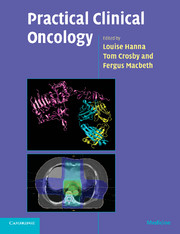Book contents
- Frontmatter
- Contents
- List of contributors
- Preface
- Acknowledgements
- Abbreviations
- 1 Practical issues in cytotoxic chemotherapy usage
- 2 Biological treatments in cancer
- 3 Hormones in cancer
- 4 Radiotherapy planning
- 5 Research in cancer
- 6 Oncological emergencies
- 7 Palliative care
- 8 Head and neck
- 9 Oesophagus
- 10 Stomach
- 11 Liver, gallbladder and biliary tract
- 12 Exocrine pancreas
- 13 Colon and rectum
- 14 Anus
- 15 Gastrointestinal stromal tumours
- 16 Breast
- 17 Kidney
- 18 Bladder
- 19 Prostate
- 20 Testis
- 21 Penis
- 22 Ovary
- 23 Body of the uterus
- 24 Cervix
- 25 Vagina
- 26 Vulva
- 27 Gestational trophoblast tumours
- 28 Lung
- 29 Mesothelioma
- 30 Soft tissue and bone tumours in adults
- 31 The lymphomas and myeloma
- 32 Central nervous system
- 33 Skin cancer other than melanoma
- 34 Melanoma
- 35 Thyroid
- 36 Neuroendocrine tumours
- 37 Cancer in children
- 38 Cancer of unknown primary
- 39 The use of radiotherapy in the treatment of benign conditions
- Multiple choice questions
- Multiple choice answers
- Index
- References
5 - Research in cancer
Published online by Cambridge University Press: 23 December 2009
- Frontmatter
- Contents
- List of contributors
- Preface
- Acknowledgements
- Abbreviations
- 1 Practical issues in cytotoxic chemotherapy usage
- 2 Biological treatments in cancer
- 3 Hormones in cancer
- 4 Radiotherapy planning
- 5 Research in cancer
- 6 Oncological emergencies
- 7 Palliative care
- 8 Head and neck
- 9 Oesophagus
- 10 Stomach
- 11 Liver, gallbladder and biliary tract
- 12 Exocrine pancreas
- 13 Colon and rectum
- 14 Anus
- 15 Gastrointestinal stromal tumours
- 16 Breast
- 17 Kidney
- 18 Bladder
- 19 Prostate
- 20 Testis
- 21 Penis
- 22 Ovary
- 23 Body of the uterus
- 24 Cervix
- 25 Vagina
- 26 Vulva
- 27 Gestational trophoblast tumours
- 28 Lung
- 29 Mesothelioma
- 30 Soft tissue and bone tumours in adults
- 31 The lymphomas and myeloma
- 32 Central nervous system
- 33 Skin cancer other than melanoma
- 34 Melanoma
- 35 Thyroid
- 36 Neuroendocrine tumours
- 37 Cancer in children
- 38 Cancer of unknown primary
- 39 The use of radiotherapy in the treatment of benign conditions
- Multiple choice questions
- Multiple choice answers
- Index
- References
Summary
Introduction
It is the responsibility of clinicians to provide the best possible care for their patients. However, this simple statement masks a much more complex issue. How does one know precisely what the best care is for a particular patient? In particular, how does one balance the likely benefits and risks for a particular course of treatment? A new drug may appear promising, but can one really be sure that it represents a real improvement on current practice? Generally speaking, unless the action of a particular treatment is both immediate and breathtaking (such as insulin for diabetic coma), we cannot be absolutely certain which treatment is best for which people. Historical comparisons, or other database-dependent methods, can prove misleading. What is required is a method that will provide reliable, convincing evidence that can be used to inform future practice.
Fortunately, there is such a tool: the randomised controlled trial (RCT). At its heart are two principles. First, through randomisation, any differences between patients receiving one treatment and those receiving another are purely down to chance; therefore, if a sufficiently large difference is detected, then it must be due to the only factor that is systematically different between the two groups, namely the treatment. Second, with large numbers of patients, it becomes easier to detect smaller treatment effects and to conclude that any differences are not the result of chance. This, the statistical aspect of RCTs, is effectively a formalisation of common sense.
- Type
- Chapter
- Information
- Practical Clinical Oncology , pp. 55 - 69Publisher: Cambridge University PressPrint publication year: 2008



